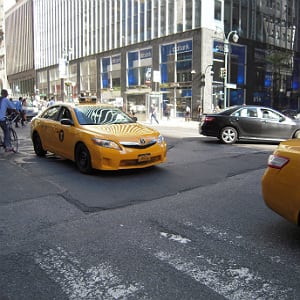According to the New York Times, pedestrian fatalities hit an all-time low in 2014. Surprisingly, the previous year saw a decade-long high, with 180 pedestrians killed in motor vehicle collisions. But last year, a relatively low 132 pedestrians were fatally struck. Pundits attribute the decrease to Bill de Blasio's Vision Zero program, which lowered the City's default speed limit to 25 miles per hour.
De Blasio has also insisted that his program enhances the penalties for reckless driving. But recent events suggest otherwise. In fact, it looks like New York's most dangerous professional drivers go unpunished after accidents, especially those involving pedestrians.
Learn more about reckless driving and types of traffic offenses associated with cab drivers: https://banvillelaw.com/cab-driver-traffic-offenses/

Jumping the curb, his yellow taxi struck a cyclist and carried the biker on its hood for a quarter block. Himon then rammed into Green, whose leg, partially severed by the cab's front wheel, would later be amputated.
After a "thorough, two-month-long investigation," New York's District Attorney's Office released its long-awaited announcement. Cy Vance, the City's DA, would not be pressing criminal charges. Despite the fact that Himon had a long record of reckless driving, including three violations in 2011 alone, despite the fact that he had broken a law in causing Green's horrific injuries, despite the fact that multiple eye-witness accounts corroborated the illegality of his actions.
Himon surrendered his cab license in August and reclaimed it a month later.
Fast forward to August 2014, Times Square. William Dalambert, a driver for GrayLine Tours, accelerates to beat a light quickly turning red. In the intersection, his double-decker bus hits an SUV and jumps onto the median. No less than 18 pedestrians were injured in the crash. The driver was subsequently arrested on suspicion of impairment, but released after chemical testing found no intoxicating substances.
Further investigation found that Dalambert had been previously cited for at least 11 moving violations, and received up to 20 separate license suspensions. Video of the accident became widely-available, substantiating the claim that he had accelerated at an orange light. That's breaking the law.
But again, Vance and the District Attorney's Office declined to press charges, writing that "at this present stage of the investigation, there is not sufficient basis to conclude that the defendant was operating the tour bus in a reckless manner."
Across the City, dangerous professional drivers are getting away with murder. In many cases, literally. So what's the hold-up?
A study in the Wall Street Journal put the problem clearly:
New York's "drivers are rarely charged criminally if they kill another person...because New York's vehicular homicide and manslaughter statutes apply only to motorists who are drunk or on drugs."
To most rational people, this seems crazy. You don't have to be impaired to commit crimes or cause serious damage. Unless you're driving in New York City. Prominent legal scholar Alan Dershowitz reports that "only about 5% of city drivers who kill pedestrians are charged with serious crimes."
In short, the law has almost no deterrent effect. When people see reckless drivers get off scot-free, with no repercussions, they're far more likely to drive recklessly themselves. It's a cycle - drivers act unsafely, cause wide-reaching injuries, and get right back on the streets.
Then it happens all over again.
Last June, New York's City Council passed Intro 238, a new law that makes drivers guilty of a misdemeanor when they hit pedestrians who have the right of way.
Notably, the statute means that reckless drivers won't just be penalized through minor fines, but real criminal charges, a permanent stain on their record.
And unlike other driving laws, Intro 238 is governed by a legal theory known as "strict liability." Under strict liability, lawyers won't have to prove that a driver knew about the risks of their behavior, but acted recklessly anyway. All they'll have to prove is that the accident happened.
Intro 238 is an effective new tool, one that could make our streets significantly safer. Unfortunately, no one's using it yet.
Between August and November of 2014, four pedestrians were killed in Chinatown by reckless drivers. The victims included a 90-year-old woman and an 82-year-old, both of whom had the right of way and were struck in the crosswalk.
These are cases in which Intro 238 could, and should, be applied. But Cy Vance hasn't pressed any criminal charges.
Until the City begins enforcing its newly-made driving laws, there's no reason for reckless motorists to shape up. And that puts all of us in danger.
Our experienced cab accident lawyers are ready to help answer any questions you may have. For similar reading: https://banvillelaw.com/can-i-sue-for-whiplash-cab-accident/